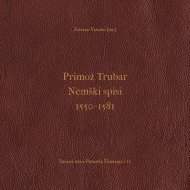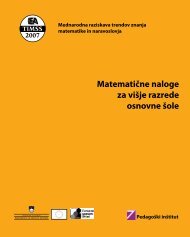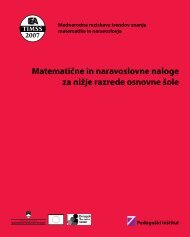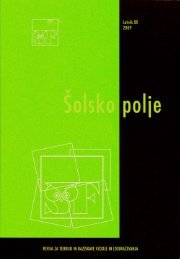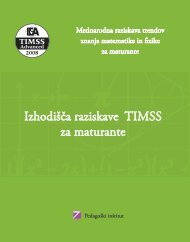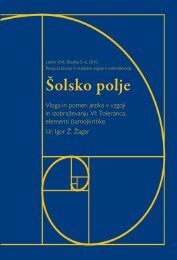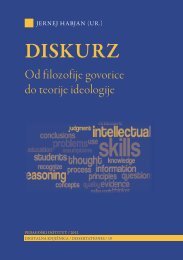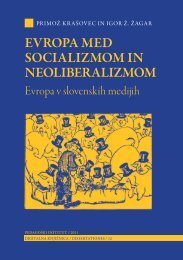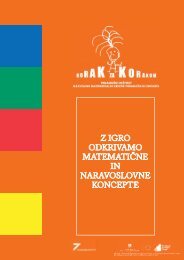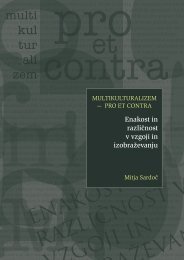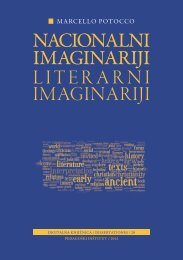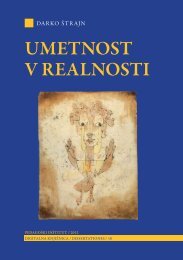96 ŠOLSKO POLJE LETNIK <strong>XX</strong> ŠTEVILKA 5/6Discussion and ConclusionIn this article, we attempted to explore how Karadžić’s arrest was representedby TS’s journalists. They still practice a so-called »nationalistic journalism«,which borrows its tactics from nationalistic ideology. Particularnostalgic sentiments were used, co-opted and appropriated by TS’s journalists,in order to achieve political goal of channelling specific interpretationsabout the past and present. In that sense Svetlana Boym’s insightthat nostalgia is the “romance with one’s own fantasy” (2001: xiii) is a veryaccurate description of the relationship between the nostalgic sentimentas employed by TS. We argue that TS’ journalists used restorative nostalgiain ways that served both commercial and state interests, consolidatingits place in an emerging synergy between government and market thatwe described, drawing on Žižek, as forming a military-poetic-media-entertainmentcomplex. In TS’s discourse, nostalgia for Greater Serbia waspresent amidst the evidence of crimes committed in its name. Moreover,Karadžić was portrayed as a leader who has at least partly realized Serbia’sexpansionist goals and made it possible for Serbs in BH to live together.TS’s journalists reproduced a specific type of nationalistic discourse– one which uses strategies of suppression of sensitive themes, includingcoverage of or reference to war crimes. Overall, TS glossed over contradictoryelements that could compromise the ideal vision of Great Serbia.Nostalgic nationalism, as expressed in TS coverage of Karadžić’s arrestrequires some kind of a disappointment in order to re-create the idealizednostalgic construction of the past community it hopes to achieve inthe future. This type of nostalgia functions as the search for continuity(Tannock, 1995). The renewed possibility of the future depends upon astrong narrative of return. TS’s narrative articulates unity in terms of loss,by invoking nostalgia for a romanticized notion of Serbian unity in thepast – a wholeness of community experience that has been eradicatedby unjust external forces. Karadžić was predominately represented in apositive light: on the one hand, as a hero and a strong politician, and onthe other, as a bio-energetic, a poet and a family man with a new identity.Any connections between Karadžić, the Serbs, and especially the currentgovernment with war crimes in BH were brushed aside. Thus, TS’s journalistsincorporated Karadžić’s arrest into the predominant nationalisticdiscourse. They recontextualized pre-existing discourses to reproducenationalism for a new, “pro-European” politics. They covered the “historicalarrest” of Radovan Karadžić without serious attempt to confront the
JOURNALISTIC (RE)PRODUCTION OF HISTORY: TELEVIZED COVERAGE OF RADOVAN ...97traumatic past and reconcile with it. In that, nostalgia employed by TS’sjournalists exploited popular culture with its entailed “banalities” of everydaylife.Notes[1] Serbian epics has always been a symbol of a national imagination (Čolović,2002). Nationalist discourse wants to establish that a nation has alwaysexisted and in doing so often articulates and reinterpretes already existingdiscourses and other available cultural material, to convey a particular senseof belonging (ibid.).[2] Greater Serbia generally and in this paper specifically refers to the specific ideawithin Serbian nationalism – whose goal it is to unite all Serbs and Serbianlands in one state. Greater Serbia generally and in this paper specifically refersto the specific idea within Serbian nationalism – whose goal it is to unite allSerbs and Serbian lands in one state (MacDonald, 2002).[3] Serbian nationalists name the Muslims in former Yugoslavia »the Turks«(Erjavec and Volčič, 2007). In this example, Bosniaks are called »the Turks«.[4] Also in quantity terms, the largest number of news programs (more than half)has been devoted to the secret life of Radovan Karadžić as Dragan Dabić.ReferencesBernstein, B. (1990). The Structure of Pedagogic Discourse. London: Routledge.Blumler, J. G. and Kavanagh, D. (1999). The third age of politicalcommunication: Influences and features. Political Communication, 16, 2, 209-230.Boym, S. (2001). The Future of Nastalgia. New York: Basic Books.Chouliaraki, L. and Fairclough, N. (1999). Discourse in Late Modernity. Edinburgh:Edinburgh University Press.Čolović, I. (2002). Politics of Identity in Serbia. New York: New York UniversityPress.Davis, F. (1979). Nostalgia, Identity and the Current Nostalgia Wave.Journal of Popular Culture, 11, 4, 414–24.De la Broose, R. (2003). Political propaganda and the plan to create a ‘State for allSerb. Reims: University of Reims.Erjavec, K. and Volčič, Z. (2007). The Kosovo battle. The Harvard InternationalJournal of Press/Politics, 12, 1, 67-86.Erjavec, K. and Volčič, Z. (<strong>2009</strong>). Rehabilitating Milošević. Social semiotics, 19, 2, 125-147.Fairclough, N. (1989). Language and power. London: Longman.Fairclough, N. (1995a). Critical discourse analysis. London: Longman.Fairclough, N. (1995b). Media discourse. London: Arnold.
- Page 3:
VSEBINA LETNIK XX ŠTEVILKA 5/6 Z
- Page 7 and 8:
UVODNA NOTICAIgor Ž. ŽagarTole pi
- Page 9 and 10:
ZA KAJ GRE V KAD - PREGLEDZGODOVINE
- Page 11 and 12:
ZA KAJ GRE V KAD - PREGLED ZGODOVIN
- Page 13:
ZA KAJ GRE V KAD - PREGLED ZGODOVIN
- Page 17 and 18:
ZA KAJ GRE V KAD - PREGLED ZGODOVIN
- Page 19 and 20:
ZA KAJ GRE V KAD - PREGLED ZGODOVIN
- Page 21 and 22:
ZA KAJ GRE V KAD - PREGLED ZGODOVIN
- Page 23 and 24:
ZA KAJ GRE V KAD - PREGLED ZGODOVIN
- Page 25 and 26:
ZA KAJ GRE V KAD - PREGLED ZGODOVIN
- Page 27 and 28:
DISKURZ: FOUCAULT, LACLAU TERZAPOPA
- Page 29 and 30:
DISKURZ: FOUCAULT, LACLAU TER ZAPOP
- Page 31 and 32:
DISKURZ: FOUCAULT, LACLAU TER ZAPOP
- Page 33 and 34:
DISKURZ: FOUCAULT, LACLAU TER ZAPOP
- Page 35 and 36:
DISKURZ: FOUCAULT, LACLAU TER ZAPOP
- Page 37 and 38:
DISKURZ: FOUCAULT, LACLAU TER ZAPOP
- Page 39 and 40:
DISKURZ: FOUCAULT, LACLAU TER ZAPOP
- Page 41 and 42:
DISKURZ: FOUCAULT, LACLAU TER ZAPOP
- Page 43 and 44:
DISKURZ: FOUCAULT, LACLAU TER ZAPOP
- Page 45 and 46:
DISKURZ: FOUCAULT, LACLAU TER ZAPOP
- Page 47 and 48: DISKURZ: FOUCAULT, LACLAU TER ZAPOP
- Page 49 and 50: TOPOI IN CRITICAL DISCOURSE ANALYSI
- Page 51 and 52: TOPOI IN CRITICAL DISCOURSE ANALYSI
- Page 53 and 54: TOPOI IN CRITICAL DISCOURSE ANALYSI
- Page 55 and 56: TOPOI IN CRITICAL DISCOURSE ANALYSI
- Page 57 and 58: TOPOI IN CRITICAL DISCOURSE ANALYSI
- Page 59 and 60: TOPOI IN CRITICAL DISCOURSE ANALYSI
- Page 61 and 62: TOPOI IN CRITICAL DISCOURSE ANALYSI
- Page 63 and 64: TOPOI IN CRITICAL DISCOURSE ANALYSI
- Page 65 and 66: TOPOI IN CRITICAL DISCOURSE ANALYSI
- Page 67 and 68: TOPOI IN CRITICAL DISCOURSE ANALYSI
- Page 69 and 70: TOPOI IN CRITICAL DISCOURSE ANALYSI
- Page 71 and 72: TOPOI IN CRITICAL DISCOURSE ANALYSI
- Page 73 and 74: TOPOI IN CRITICAL DISCOURSE ANALYSI
- Page 75 and 76: TOPOI IN CRITICAL DISCOURSE ANALYSI
- Page 77 and 78: University of Queensland, Centre fo
- Page 79 and 80: JOURNALISTIC (RE)PRODUCTION OF HIST
- Page 81 and 82: JOURNALISTIC (RE)PRODUCTION OF HIST
- Page 83 and 84: JOURNALISTIC (RE)PRODUCTION OF HIST
- Page 85 and 86: JOURNALISTIC (RE)PRODUCTION OF HIST
- Page 87 and 88: JOURNALISTIC (RE)PRODUCTION OF HIST
- Page 89 and 90: JOURNALISTIC (RE)PRODUCTION OF HIST
- Page 91 and 92: JOURNALISTIC (RE)PRODUCTION OF HIST
- Page 93 and 94: JOURNALISTIC (RE)PRODUCTION OF HIST
- Page 95 and 96: JOURNALISTIC (RE)PRODUCTION OF HIST
- Page 97: JOURNALISTIC (RE)PRODUCTION OF HIST
- Page 101 and 102: JOURNALISTIC (RE)PRODUCTION OF HIST
- Page 103 and 104: THE VOICE OF AN AGENDA-SETTINGAUTHO
- Page 105 and 106: THE VOICE OF AN AGENDA-SETTING AUTH
- Page 107 and 108: THE VOICE OF AN AGENDA-SETTING AUTH
- Page 109 and 110: THE VOICE OF AN AGENDA-SETTING AUTH
- Page 111 and 112: THE VOICE OF AN AGENDA-SETTING AUTH
- Page 113 and 114: THE VOICE OF AN AGENDA-SETTING AUTH
- Page 115 and 116: THE VOICE OF AN AGENDA-SETTING AUTH
- Page 117 and 118: THE VOICE OF AN AGENDA-SETTING AUTH
- Page 119 and 120: THE VOICE OF AN AGENDA-SETTING AUTH
- Page 121 and 122: THE VOICE OF AN AGENDA-SETTING AUTH
- Page 123 and 124: THE VOICE OF AN AGENDA-SETTING AUTH
- Page 125 and 126: THE VOICE OF AN AGENDA-SETTING AUTH
- Page 127 and 128: THE VOICE OF AN AGENDA-SETTING AUTH
- Page 129 and 130: THE VOICE OF AN AGENDA-SETTING AUTH
- Page 131 and 132: THE VOICE OF AN AGENDA-SETTING AUTH
- Page 133 and 134: THE VOICE OF AN AGENDA-SETTING AUTH
- Page 135 and 136: ‘68 KOT HKRATNA KRIZA EVROPSKEGAZ
- Page 137 and 138: ‘68 KOT HKRATNA KRIZA EVROPSKEGA
- Page 139 and 140: ‘68 KOT HKRATNA KRIZA EVROPSKEGA
- Page 141 and 142: ‘68 KOT HKRATNA KRIZA EVROPSKEGA
- Page 143 and 144: ‘68 KOT HKRATNA KRIZA EVROPSKEGA
- Page 145 and 146: ‘68 KOT HKRATNA KRIZA EVROPSKEGA
- Page 147 and 148: ‘68 KOT HKRATNA KRIZA EVROPSKEGA
- Page 149 and 150:
‘68 KOT HKRATNA KRIZA EVROPSKEGA
- Page 151 and 152:
‘68 KOT HKRATNA KRIZA EVROPSKEGA
- Page 153 and 154:
‘68 KOT HKRATNA KRIZA EVROPSKEGA
- Page 155 and 156:
‘68 KOT HKRATNA KRIZA EVROPSKEGA
- Page 157 and 158:
‘68 KOT HKRATNA KRIZA EVROPSKEGA
- Page 159 and 160:
POVZETKI/ABSTRACTSZA KAJ GRE V KAD
- Page 161 and 162:
POVZETKI / ABSTRACTS159NOVINARSKA (
- Page 163 and 164:
POVZETKI / ABSTRACTS161‘68 AS PAR
- Page 165 and 166:
AVTORJI/AUTHORSRuth WodakRuth Wodak
- Page 168 and 169:
166 ŠOLSKO POLJE LETNIK XX ŠTEV
- Page 170 and 171:
168 ŠOLSKO POLJE LETNIK XX ŠTEV
- Page 172:
ZAHVALARevija Šolsko polje izhaja



